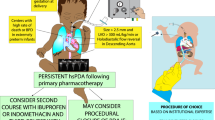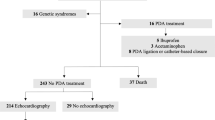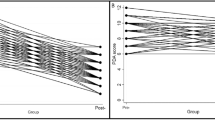Abstract
Patent ductus arteriosus (DA) is the second most common congenital heart defect, the incidence of which is increased in premature infants, although mechanisms responsible are not clear. Our previous studies with genetic or pharmacological inactivation of cyclooxygenase-2 (COX-2) in mice, emphasized the importance of this enzyme in normal DA closure. The current study was designed to determine whether reduced COX-2 expression contributes to patent DA in preterm mice. Real-time PCR analysis indicated that COX-2 expression in the fetal mouse DA significantly increased with advancing gestational age. Furthermore, we observed a significant induction in COX-2 expression in the DA at 3 h after birth at full-term gestation. In contrast, COX-2 expression was significantly attenuated in the DA of preterm neonatal mice. DA closure was incomplete in preterm mice at 3 h postpartum, a time-point when the DA of full-term neonates was completely remodeled. Additionally, COX-2 expression was significantly attenuated in the DA of mice deficient in the prostanoid receptor EP4, which also show a patent DA phenotype, suggesting the importance of this receptor for the induction of COX-2 required for DA closure. Overall, these studies suggest that attenuated expression of COX-2 may contribute to increased patent DA at preterm gestation.
Similar content being viewed by others

Log in or create a free account to read this content
Gain free access to this article, as well as selected content from this journal and more on nature.com
or
Abbreviations
- DA:
-
ductus arteriosus
- COX:
-
cyclooxygenase
- E:
-
eosin
- H:
-
hematoxylin
- HPRT:
-
hypoxanthine phospho-ribosyl transferase
- PG:
-
prostaglandin
References
Clyman RI, Hardy P, Waleh N, Chen YQ, Maury F, Fouron JC, Chemtob S 1999 Cyclooxygenase-2 plays a significant role in regulating the tone of the fetal lamb ductus arteriosus. Am J Physiol 276: R913–R921
Mani A, Meraji SM, Houshyar R, Radhakrishnan J, Ahangar M, Rezaie TM, Taghavinejad MA, Broumand B, Zhao H, Nelson-Williams C, Lifton RP 2002 Finding genetic contributions to sporadic disease: a recessive locus at 12q24 commonly contributes to patent ductus arteriosus. Proc Natl Acad Sci U S A 99: 15054–15059
Mitchell SC, Korones SB, Berendes HW 1971 Congenital heart disease in 56,109 births. Incidence and natural history. Circulation 43: 323–332
Smith GC 1998 The pharmacology of the ductus arteriosus. Pharmacol Rev 50: 35–58
Smith WL, DeWitt DL 1996 Prostaglandin endoperoxide H synthases-1 and -2. Adv Immunol 62: 167–215
Guerguerian AM, Hardy P, Bhattacharya M, Olley P, Clyman RI, Fouron JC, Chemtob S 1998 Expression of cyclooxygenases in ductus arteriosus of fetal and newborn pigs. Am J Obstet Gynecol 179: 1618–1626
Coceani F, Ackerley C, Seidlitz E, Kelsey L 2001 Function of cyclo-oxygenase-1 and cyclo-oxygenase-2 in the ductus arteriosus from fetal lamb: differential development and change by oxygen and endotoxin. Br J Pharmacol 132: 241–251
Loftin CD, Trivedi DB, Tiano HF, Clark JA, Lee CA, Epstein JA, Morham SG, Breyer MD, Nguyen M, Hawkins BM, Goulet JL, Smithies O, Koller BH, Langenbach R 2001 Failure of ductus arteriosus closure and remodeling in neonatal mice deficient in cyclooxygenase-1 and cyclooxygenase-2. Proc Natl Acad Sci U S A 98: 1059–1064
Loftin CD, Trivedi DB, Langenbach R 2002 Cyclooxygenase-1-selective inhibition prolongs gestation in mice without adverse effects on the ductus arteriosus. J Clin Invest 110: 549–557
Narumiya S, Sugimoto Y, Ushikubi F 1999 Prostanoid receptors: structures, properties, and functions. Physiol Rev 79: 1193–1226
Waleh N, Kajino H, Marrache AM, Ginzinger D, Roman C, Seidner SR, Moss TJ, Fouron JC, Vazquez-Tello A, Chemtob S, Clyman RI 2004 Prostaglandin E2–mediated relaxation of the ductus arteriosus: effects of gestational age on g protein-coupled receptor expression, signaling, and vasomotor control. Circulation 110: 2326–2332
Nguyen M, Camenisch T, Snouwaert JN, Hicks E, Coffman TM, Anderson PA, Malouf NN, Koller BH 1997 The prostaglandin receptor EP4 triggers remodelling of the cardiovascular system at birth. Nature 390: 78–81
Segi E, Sugimoto Y, Yamasaki A, Aze Y, Oida H, Nishimura T, Murata T, Matsuoka T, Ushikubi F, Hirose M, Tanaka T, Yoshida N, Narumiya S, Ichikawa A 1998 Patent ductus arteriosus and neonatal death in prostaglandin receptor EP4-deficient mice. Biochem Biophys Res Commun 246: 7–12
French MC, Littlejohn RP, Greer GJ, Bain WE, McEwan JC, Tisdall DJ 2006 Growth hormone and ghrelin receptor genes are differentially expressed between genetically lean and fat selection lines of sheep. J Anim Sci 84: 324–331
Smith GC, Wu WX, Nijland MJ, Koenen SV, Nathanielsz PW 2001 Effect of gestational age, corticosteroids, and birth on expression of prostanoid EP receptor genes in lamb and baboon ductus arteriosus. J Cardiovasc Pharmacol 37: 697–704
Bhattacharya M, Asselin P, Hardy P, Guerguerian AM, Shichi H, Hou X, Varma DR, Bouayad A, Fouron JC, Clyman RI, Chemtob S 1999 Developmental changes in prostaglandin E-2 receptor subtypes in porcine ductus arteriosus—possible contribution in altered responsiveness to prostaglandin E-2. Circulation 100: 1751–1756
Smith GC, McGrath JC 1988 Indomethacin, but not oxygen tension, affects the sensitivity of isolated neonatal rabbit ductus arteriosus, but not aorta, to noradrenaline. Cardiovasc Res 22: 910–915
Reese J, Anderson JD, Brown N, Roman C, Clyman RI 2006 Inhibition of Cyclooxygenase isoforms in late- but not mid-gestation decreases contractility of the ductus arteriosus and prevents postnatal closure in mice. Am J Physiol Regul Integr Comp Physiol doi: 10.1152/ajpregu. 00259.2006 (accessed August 30, 2006)
Moise KJ 1993 Effect of advancing gestational age on the frequency of fetal ductal constriction in association with maternal indomethacin use. Am J Obstet Gynecol 168: 1350–1353
Momma K, Takao A 1987 In vivo constriction of the ductus arteriosus by nonsteroidal antiinflammatory drugs in near-term and preterm fetal rats. Pediatr Res 22: 567–572
Bouayad A, Fouron JC, Hou X, Beauchamp M, Quiniou C, Abran D, Peri K, Clyman RI, Varma DR, Chemtob S 2004 Developmental regulation of prostaglandin E2 synthase in porcine ductus arteriosus. Am J Physiol Regul Integr Comp Physiol 286: R903–R909
Regan JW 2003 EP2 and EP4 prostanoid receptor signaling. Life Sci 74: 143–153
Bradbury DA, Newton R, Zhu YM, El-Haroun H, Corbett L, Knox AJ 2003 Cyclooxygenase-2 induction by bradykinin in human pulmonary artery smooth muscle cells is mediated by the cyclic AMP response element through a novel autocrine loop involving endogenous prostaglandin E2, E-prostanoid 2 (EP2), and EP4 receptors. J Biol Chem 278: 49954–49964
Acknowledgements
The authors thank Dr. Robert Langenbach (National Institutes of Health/National Institute of Environmental Health Sciences, Research Triangle Park, NC) for providing the breeder pairs of COX-2 wild-type mice and Drs. Shuh Narumiya (Kyoto University, Kyoto, Japan) and Takayuki Maruyama (Ono Pharmaceuticals, Osaka, Japan) for the EP4 heterozygous-deficient breeding pairs.
Author information
Authors and Affiliations
Corresponding author
Additional information
This work was supported by a Scientist Development Grant (0430153N) from the American Heart Association.
Rights and permissions
About this article
Cite this article
Trivedi, D., Sugimoto, Y. & Loftin, C. Attenuated Cyclooxygenase-2 Expression Contributes to Patent Ductus Arteriosus in Preterm Mice. Pediatr Res 60, 669–674 (2006). https://doi.org/10.1203/01.pdr.0000246480.13170.c0
Received:
Accepted:
Issue date:
DOI: https://doi.org/10.1203/01.pdr.0000246480.13170.c0


